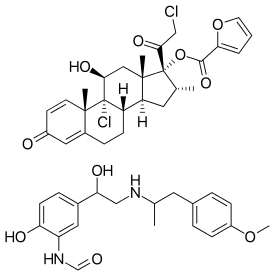Mometasone/formoterol
Mometasone/formoterol, sold under the brand name Dulera among others, is a combination medication used in the long-term treatment of asthma.[1] It contains mometasone a steroid and formoterol a long-acting beta agonist.[1] It is only recommended in those in who an inhaled steroid is not sufficient.[1] It is used by inhalation.[1] It should not be used for sudden worsening of asthma.[1]
 | |
| Combination of | |
|---|---|
| Mometasone furoate | Corticosteroid |
| Formoterol | Long-acting β2 adrenoreceptor agonist (LABA) |
| Clinical data | |
| Trade names | Zenhale, Dulera, others |
| AHFS/Drugs.com | FDA Professional Drug Information |
| License data | |
| Pregnancy category |
|
| Routes of administration | Inhalation (MDI) |
| ATC code | |
| Legal status | |
| Legal status | |
| Identifiers | |
| KEGG | |
| | |
Common side effect include headache and sinusitis.[2] More serious side effects may include thrush, immunosuppression, allergic reactions, and cataracts.[2] Use is not recommended in those less than 12 years of age.[2] It has not been studied during pregnancy or breastfeeding.[2] Mometasone works by decreasing inflammation well formoterol works by relaxing smooth muscle in the airways.[2]
The combination was approved for medical use in the United States in 2010.[1] No generic version is available as of 2019.[3] In the United States the wholesale cost of a puffer is about 202 USD as of 2019.[4] In 2016 it was the 203rd most prescribed medication in the United States with more than 2 million prescriptions.[5] It is not approved for use in Europe.[6]
Medical use
It is used in the long-term treatment of asthma.[1]
It is not for the treatment of acute bronchospasm.[7] To relieve acute symptoms, a rapid-onset short-duration inhaled bronchodilator (such as salbutamol) should be available.[8]
Warnings and precautions
Long-acting β adrenoreceptor agonists (LABAs) are subject to a boxed warning against the possibility of an increased risk of asthma-related death.[8] Formoterol belongs to the LABA class of drugs. As there does not exist at the time of the monograph's publication adequate research to determine whether the rate of asthma-related death is increased with formoterol, it is therefore recommended by the FDA that LABAs only be used for patients not adequately controlled on other asthma controlling medications or whose disease severity clearly warrants initiation of dual therapy.[9]
Side effects
The most commonly reported side effects were: oral thrush, nausea, headache, and pain in the pharynx or larynx. More rarely reported side effects (occurring in <1% of patients during the clinical trial) include: tachycardia, palpitations, dry mouth, allergic reaction (bronchospasm, dermatitis, hives), pharyngitis, muscle spasms, tremor, dizziness, insomnia, nervousness, and hypertension. Patients experiencing an allergic reaction or increase in difficulty breathing while using this medication should immediately discontinue its use and contact their physician.[10]
Society and culture
Dosage
Mometasone/formoterol is available in a pressurized MDI (pMDI) in three strengths (in micrograms of mometasone/micrograms of formoterol): 50/5, 100/5, and 200/5. The following is the manufacturer's recommended dose based on prior asthma therapy:[8]
- Inhaled low-dose corticosteroids: 50/5 two inhalations twice daily to a maximum of 200/20 micrograms daily
- Inhaled medium-dose corticosteroids: 100/5 two inhalations twice daily to a maximum of 400/20 micrograms daily
- Inhaled high-dose corticosteroids: 200/5 two inhalations twice daily to a maximum of 800/20 micrograms daily
Market
Zenhale was approved in Canada in early 2011.[11] Dulera was approved by the Food and Drug Administration (FDA) in the United States in June 2010.[12] Zenhale's marketing application was voluntarily withdrawn from the EU due to the manufacturer's inability to provide additional information in the necessary timeframe.[6]
References
- "Dulera - FDA prescribing information, side effects and uses". Drugs.com. Retrieved 19 April 2019.
- "DailyMed - mometasone furoate and formoterol fumarate dihydrate aerosol". dailymed.nlm.nih.gov. Retrieved 19 April 2019.
- "Dulera Prices, Coupons & Patient Assistance Programs". Drugs.com. Retrieved 19 April 2019.
- "NADAC as of 2019-02-27". Centers for Medicare and Medicaid Services. Retrieved 3 March 2019.
- "The Top 300 of 2019". clincalc.com. Retrieved 22 December 2018.
- "Withdrawal of the marketing authorisation application for Zenhale (mometasone furoate/formoterol fumarate) Questions and Answers" (PDF). European Medicines Agency.
- Waknine, Yael. "FDA Approves Mometasone-Formoterol Combo for Asthma". Medscape Today FDA Approvals. Medscape. Retrieved August 16, 2011.
- "Zenhale product monograph" (PDF). Merck Canada. Retrieved August 16, 2011.
- Donohue MD, Dr. James F. "Asthma Medications: Black Box Warnings -- Where Do We Go From Here?". Medscape. Retrieved August 16, 2011.
- "Zenhale Patient Information" (PDF). Zenhale Product Monograph. Merck & Co. Retrieved August 16, 2011.
- "British Columbia Drug and Poison Information Center". BC DPIC.
- "Merck's DULERA Inhalation Aerosol for asthma receives FDA approval". News-Medical.net.